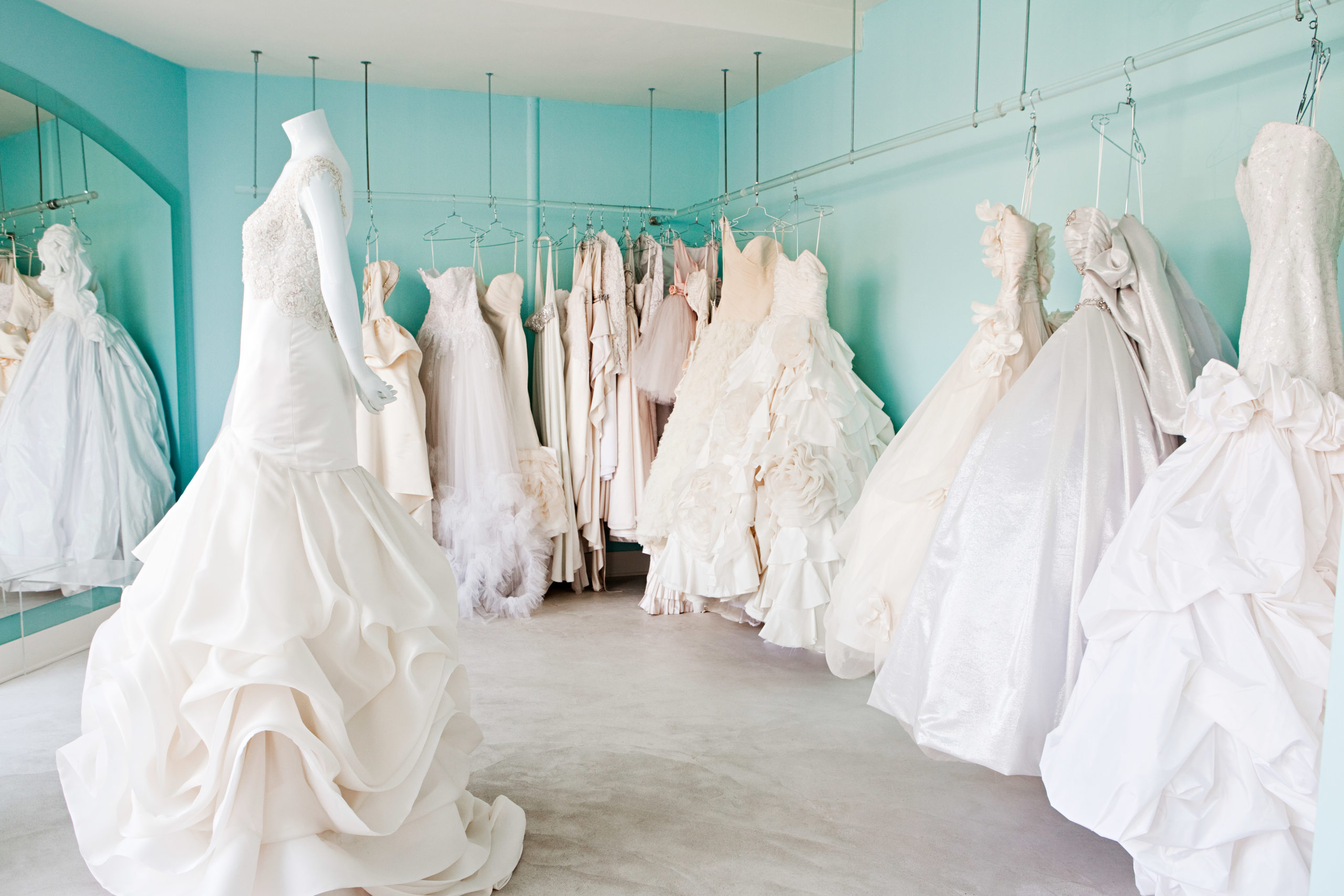I got married in a beautiful Alfred Angelo gown in 2013.
I loved my dress, but my new husband and I lived in a small apartment, and the dress took up half of our closet space.
We also needed some extra cash to start building our new life together, so I made what some people saw as a drastic decision: I decided to sell my wedding dress just six months after getting married.
Plenty of people told me it was bad luck to sell my wedding dress, but I’m not superstitious. I’m very practically focused, and the need for extra storage space and extra money won over any concerns that other people raised.
If you’re like me and thinking of selling your gown, you have options. Here’s how I did it and how much I netted.
How To Sell Your Wedding Dress in 6 Steps
Selling your wedding dress is more complicated than selling a pair of shoes on eBay. Here are six steps I took to sell my wedding dress online.
Step No. 1: Get your wedding dress professionally cleaned
If you’re planning to sell your wedding dress, have it professionally cleaned. Potential buyers are brides themselves, and they want their new dress to be immaculate — not spotted with wine stains or cake from your own celebration.
Taking your dress to the dry cleaner is an added expense, but it can help you sell your dress more quickly. You’re also more likely to have a satisfied customer.
According to BravoBride, a site where you can buy and sell used wedding items, you can generally have your gown cleaned for $100 to $200. The exact price you’ll pay depends on your location and the intricacy and fabric of your gown.
My dress was relatively simple; it was ivory satin with only a little bit of beading around the bodice. It was in fairly good condition, but it did have some spots from grass and dirt around the hem. I was able to get my dress cleaned for just $95.
Step No. 2: Provide ample pictures of your wedding dress
When preparing your dress for sale, take lots of pictures. Make sure you include:
- Stock photos: If possible, include stock photos from the company that made your dress in your listing. People who have a particular dress in mind will look for those photos.
- Pictures of alterations: If you had any special alterations done that changed the look of the dress, include photos of those changes, too. In my case, the seamstress added a French bustle to my gown. Brides.com, a leading wedding site, reported that adding a bustle can cost between $75 and $250. In my case, having the bustle already completed was an added selling feature for the dress.
- Wedding day photos: If possible, include photos from your wedding day to show the finished dress, and to highlight how beautiful it can look with your makeup and hair done.
- Photos after having the dress cleaned: Take pictures of the dress after its cleaning and include a photo of the dry cleaner receipt as proof that it was cleaned. Include close-ups of any details, such as beading or lace, to show that it’s in good condition and that there aren’t missing elements or tears.
Step No. 3: Choose where you sell your wedding dress carefully
Where to sell your wedding dress is a big decision as it can affect your price and total experience. While you can sell your dress to a local consignment shop, the clientele may be limited. You may be able to reach more people by selling it online through a site like Tradesy, Pre-Owned Wedding Dresses, or Still White.
After reviewing my options, I decided to list my dress on Tradesy because it has no upfront fees. Instead, it charges a 19.8% commission on the final sales price. It also offers pricing suggestions and selling tips, and protects sellers if a buyer returns an item due to an issue that isn’t the seller’s fault.
Step No. 4: Be precise about the details of your wedding dress
In your listing, share as much detail as possible about the gown, its condition, and any alterations.
Details are particularly important when it comes to sizing. Wedding dress sizes tend to be quite different than sizing for regular clothes, so make sure you list measurements for the dress. If you had any alterations made to the dress that affect its measurements, include those, too.
I’m fairly short and wore flats for my wedding, so I had my dress hemmed quite a bit. The seamstress also took in the bodice about two inches to fit my waist. In my listing for the dress, I included the manufacturer’s original measurements taken from its website and my own measurements to highlight how the dress would fit someone else.
I listed my dress with the following details:
- Size 16W Alfred Angelo gown
- Manufacturer measurements:
- Bust: 43
- Waist: 37
- Hips: 48
- Post-alteration measurements:
- Bust: 42
- Waist: 35
- Hips: 48
- Alterations completed:
- French bustle added
- Hemmed to skim the floor for someone who is 5’4” wearing flats
- Description: Used Alfred Angelo gown style 1136. Gorgeous satin A-line gown with beading at corset back. Semi-cathedral train. Worn at my own wedding. I spent about $350 on alterations to add a French bustle and to take in the waist. It’s been hemmed to accommodate my height; I’m 5’4” and wore flats. The dress has been professionally cleaned.
Step No. 5: Research wedding dress pricing
When deciding on how to price your wedding dress, do some homework first. In general, dresses that are under two years old can sell for about 50 percent of their original retail price. According to The Knot, a top wedding planning site, designer gowns from brands like Vera Wang can fetch up to 60 percent of their original price.
However, if you’ve made significant alterations to the dress or if there are stains that won’t come out, you may have to charge less for the gown.
My dress was originally $1,000, and I spent about $350 on alterations. Because my dress was hemmed so much, I knew that the market for the gown would be limited. It would be too short for anyone who was taller than me or for anyone who wanted to wear heels with their gown. Because of that limitation, I followed Tradesy’s recommendation to price my dress at $450.
My dress sold for its full asking price within two weeks of me posting the listing. Thanks to my careful details in the listing, a woman who was my exact height purchased the dress.
My buyer didn’t have any questions, but you may receive questions or requests for more photos from potential customers. Check your account daily so you can respond in a timely manner to improve your chances of making a sale.
Step No. 6: Insure before you ship the wedding dress
Next, it’s time to ship the dress.
Depending on what site you use to sell your dress, the company may send you packaging materials and a prepaid shipping label. Tradesy’s shipping policy didn’t allow me to take advantage of their shipping kit, so I had to handle shipping on my own.
I shipped the dress in a large box and kept it wrapped in the plastic covering from the dry cleaner. I insured the gown for its sale price, which I highly recommend you do in case the dress is lost or damaged during transport.
In my listing, I noted that the buyer was responsible for shipping and insuring the dress, so they spent about $50 to cover those costs in addition to the dress’s sale price.
The Afterglow of Selling My Wedding Dress
Once the dress arrived at my buyer’s home, she messaged me to tell me how thrilled she was with it.
The style of the gown was her dream wedding dress, but its retail price had been out of her price range. Buying it used on Tradesy allowed her to get the dress she really wanted without spending more than she could afford.
I was so happy that my dress brought someone else joy, too. Thanks to that experience, I’ve never regretted selling my gown.
After deducting Tradesy’s commission and the cost of having the wedding dress cleaned, I pocketed about $250 from selling the gown. While not a huge sum, selling my wedding gown freed up space in my closet and I used the money to bolster my emergency fund.



